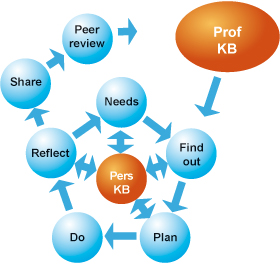Use 'Print preview' to check the number of pages and printer settings.
Print functionality varies between browsers.
Printable page generated Sunday, 23 November 2025, 2:23 AM
V04s: Learning platforms: all aboard
Course information

What you need to do the course
- a computer with a web browser
- a VLE in your school
- access to the school’s VLE implementation plan
- access to staff within the school who have responsibility for VLE implementation.
Duration of the course: 20 hours over eight weeks
- Online total: 9 hours
- Offline total: 11 hours
- face-to-face: 0 hours
- workplace: 11 hours (researching present use of the VLE in school; meeting with head or lead name; reading school’s implementation plan, reflection on school implementation, editing implementation plan).
Learning outcomes
Professional and reflective practitioner skills
At the completion of this course, you should be able to:
- play an active role in you school’s implementation of its VLE
- lead a team of practitioners in the implementation of your school’s VLE - where appropriate to your role.
Practical skills
At the completion of this course, you should be able to:
- complete a plan for the implementation of a VLE in your school.
Knowledge and understanding
At the completion of this course, you should be able to demonstrate:
- an understanding of the ways in which a VLE can be used to improve teaching and learning
- an understanding of the ways in which VLEs can be used for collaborative activities that engage all members of the school and its wider community.
Cognitive skills
At the completion of this course, you should be able to:
- discuss different ways in which VLEs might be used in learning contexts in schools.
Course schedule
| Week | Activities | Type | Duration |
| 1 | Activity 1 Getting to know others on the course | Online | 1 hour |
| 1–2 | Activity 2 VLE - Basic information Activity 3 VLE - Usage information | Workplace | 2 hours |
| 1–3 | Activity 4 VLE - Leadership team view | Workplace | 2 hours |
| Activity 5 VLE – staff view | Workplace | 2 hours | |
| 3 | Activity 6 VLE - Summarizing your understanding | Workplace | 2 hours |
| 4 | Activity 7 Sharing initial findings in the forum. | Online | 2 hours |
| 5 | Activity 8 VLE implementation, pedagogy and society | Online | 2 hours |
| Activity 9 VLE implementation, policy agenda | Online | 2 hours | |
| 6–8 | Activity 10 Developing the plan | Workplace | 3 hours |
| 8 | Activity 11 Extracting our shared learning | Online | 1 hour |
| Activity 12 Evaluation and certification | Online | 1 hour | |
| Total 20 hours |
Introduction

This is a course designed to help senior leaders gain greater value from their VLE. The emphasis will be on you understanding the range of opportunities afforded by the VLE and on understanding different models of implementation. You will:
- create a clear picture of the place of the VLE within your school at the beginning of the course
- look at background readings and examples of how VLEs are used, discussing these with other members of the course
- develop the plan for implementation in your school.
You will need to:
- recognise how your school is presently planning to use the VLE
- collate a set of information such as who your VLE provider is, what training and support they offer, the role of the local authority and the training plan for staff in your school.
The reflective cycle
Vital courses are based on a cycle of professional reflective practice as shown in the diagram below.

This cycle draws on, and develops, personal and professional knowledge bases. The latter may be seen in the literature, resources, policies and other materials that are used to inform practice.
Throughout the course small icons will indicate the stage of the cycle being addressed.
NB Prof/Pers KB = Professional/Personal knowledge base
Introducing ourselves
In this first part of the course we will introduce ourselves so as to get to know who else is on the course as we will be sharing our thoughts and experiences with each other.
Activity 1 Getting to know others on the course
![]() The objective of this course activity is to get to know the other participants on this course.
The objective of this course activity is to get to know the other participants on this course.
Introduce yourself by going to the course forum and adding something about you, your school and your VLE. Further guidance will be given in the forum.
My school and the VLE

During this part of the course you will develop your view of where your school currently stands in relation to the VLE. You will carry out a number of ‘research’ activities that will arm you with basic information about your school’s state of VLE implementation.
You will need to find time to talk to the head, to locate and read the VLE implementation plan and to locate and talk to teachers, including those who have already undertaken VLE training.
Key to this part of the course is finding out the headteacher and leadership team’s vision in relation to the use of the VLE and how this links with the wider school vision and the School’s Development Plan.
Activity 2 VLE – Basic information
![]() The objective of this course activity is to collect some basic information about your school’s VLE.
The objective of this course activity is to collect some basic information about your school’s VLE.
Your task is to find out:
- Which VLE your school is using (e.g. Fronter, Moodle, Frog, Blackboard, etc)?
- Which company or organisation supplied the VLE and what support do they offer?
- What support is offered by your local authority or other agency?
You should keep notes of your findings so that you can reflect on them in later Activities and draw on them in discussion with others and in developing your school’s implementation plan.
Activity 3 VLE – Usage information
![]() The objective of this course activity is to collect some basic information about your school’s VLE usage.
The objective of this course activity is to collect some basic information about your school’s VLE usage.
The notes in all activities in this course should be kept secure and you should let all parties to the discussion know that you are making and keeping notes and the purposes to which you will put them.
Your task is to collect data on the extent to which the VLE is used. This may be best collected from the staff responsible for its management. VLEs will usually provide such staff with usage reports. Typical data that you should collect will include:
- how many staff make use of the VLE
- the extent to which students use the VLE
- the extent to which pupils/students and their parents can access the VLE and the extent to which they are/will be expected to (and actually do).
You should keep a record of your findings. This may either be the reports themselves and/or summary notes.
Activity 4 VLE – Leadership team view
![]() The objective of the activities in this part of the course is to develop your understanding of the ways in which the VLE is used in your school setting, and the plans being used for its implementation.
The objective of the activities in this part of the course is to develop your understanding of the ways in which the VLE is used in your school setting, and the plans being used for its implementation.
Set up meetings with your headteacher and, if appropriate, other members of the school leadership team to discuss their vision and plans for the implementation of the VLE. Questions to ask include:
- What plans the school has already put in place for implementation?
- How do these plans tie in with the wider school vision and Development Plan?
- How the staff training is being planned , including which members of staff have been trained and to what level?
You should keep a record of your findings, including:
- a copy of any existing implementation plan
- notes on your meetings with the headteacher/other senior leaders.
At the end of the course, in Activity 10, you will feed back to the headteacher and leadership team any proposed developments to the plan in the light of subsequent activities.
Activity 5 VLE – Staff view
![]() Set up meetings with other staff who have been trained to use the VLE, or those that you know from the usage reports are active users. Questions to ask include:
Set up meetings with other staff who have been trained to use the VLE, or those that you know from the usage reports are active users. Questions to ask include:
- the extent to which they use the VLE to support their professional activities outside the classroom (e.g. planning, record keeping, communicating with colleagues or parents)
- the extent to which they use the VLE in their teaching
- the types of activity they use it for with students
- the strengths and weaknesses in its use as they perceive them
- their reflections on their students’ attitudes to its use
- the impact it is having on students’ learning (e.g. in terms of motivation, behaviour, engagement with the curriculum, collaboration, performance, results).
You should keep a record of your findings, including:
- notes on your meetings
- any evidence that staff have provided you with about how they use the VLE or the impact it is having on them or their students’ learning.
Activity 6 VLE – Summarizing your understanding
![]() The objectives of this course activity are to:
The objectives of this course activity are to:
- summarize your findings from the other activities in this part of the course
- reflect on those findings ready to share with others.
While carrying out the other activities in this part of the course you will have collected a range of notes and data. You should now reflect on these and use them to carry out a SWOT analysis. A chart is available for this here.
Sharing initial findings

You will now share your findings from your initial ‘research’ in Activities 2 to 5 with the other participants on the course. Having done so you will begin to build up a picture of the contexts of other course participants, and the way in which they are going about using a VLE. In later parts of the course you will be asked to reflect on your plans with reference to published research, guidance and policy.
Activity 7 Sharing initial findings in the forum
![]() The objective of this course activity is to share and discuss ways in which VLEs are being implemented in participants’ schools.
The objective of this course activity is to share and discuss ways in which VLEs are being implemented in participants’ schools.
7.1 Go to the course forum and, in the discussion called ‘Sharing initial findings’, post a message in which you summarise your key points from the SWOT analysis and findings from Activities 2 to 5.
7.2 Read the posts of other participants and discuss the ways in which their plans are similar or different to your own. You may find you need to ask for further information in order to make sense of how another participant’s school is using their VLE.
Remember to return to this discussion every day or so to respond to any replies to your message and to engage with any new posts in the discussion.
Issues: Pedagogy and society

The introduction of a VLE, or the ways in which this is implemented, will be driven by needs of the teachers and learners, pedagogical considerations and issues related to the wider school community and its social context. The needs of teachers and learners and the school’s approach to the curriculum will affect the way in which a VLE is viewed and used. The context of the school will affect the ways in which the VLE is used out-of-school (e.g. for continuation of work started in the classroom, for access to resources and to other students outside of the school day, for parental access to homework tasks, assessment reports etc.).
Activity 8 VLE implementation, pedagogy and society
![]() The objective of this course activity is to develop your understanding of the pedagogical and societal issues for VLE implementation and to reflect on this in the context of your own school.
The objective of this course activity is to develop your understanding of the pedagogical and societal issues for VLE implementation and to reflect on this in the context of your own school.
8.1. Watch this Teachers TV programme, which considers the use of a VLE in a secondary school in Cumbria. In particular it looks at ways in which their use of the VLE enhances and promotes discussion, administers tests, reduces administration and supports a reading week initiative. As you watch the programme note down issues that are pertinent to your school’s implementation of its VLE.
8.2 Go to the course forum and, in the Discussion called ‘Discussing the Teachers TV programme’, post a message that lists the key points that emerged from your watching of the video when you reflect on your own school’s VLE implementation.
8.3 Read this article (Fanning, 2008), which reports on the ways in which VLEs might be used in schools and considers their role in the context of the traditional school day and lesson. Fanning argues that as the VLE introduces opportunities for more flexible ways of working, this has a fundamental impact on structures for learning. He considers the ways in which learning at home and school can be linked by the used of a VLE and the constraints and opportunities for this.
As you read the article, consider the relationship of a VLE to engagement by teachers, students/pupils and parents. Note down three issues that you think are particularly relevant to your school.
8.4 Go to the course forum and, in the Discussion called ‘Discussing the article by Fanning’, post the points that emerged for you when you read the article and considered issues of engagement. Where appropriate, you may ask others in the group for their thoughts on these issues and, similarly, respond to others’ posts.
8.5 Read this article Berry (2006), which looks at the use of a VLE from the point of view of knowledge sharing. Thus inter-relationships between software and the exchange of data is considered. Alongside this, the ways in which teachers and pupils work and share together is reported on.
8.6 Go to the course forum and, in the Discussion called ‘Discussing the article by Berry’ post the points that emerged for you when you read the article and considered issues of knowledge sharing. Where appropriate, you may ask others in the group for their thoughts on these issues and, similarly, respond to others’ posts.
8.7 Make your own notes to summarise the key things emerging for your school’s implementation of its VLE from Activities 8.1 to 8.6.
What does policy say?

The previous part of the course considered issues of pedagogy and the context of the school. In this part we consider issues of VLE implementation from the perspective of Government policy, which aims for all schools to have a VLE/learning platform and for all learners to be engaged in their use (Becta, 2010).
Activity 9 VLE implementation, policy agenda
![]() The objective of this course activity is to develop your understanding of the policy agenda for VLE implementation and to reflect on this in the context of your own school. This activity is based on two short articles about this policy agenda.
The objective of this course activity is to develop your understanding of the policy agenda for VLE implementation and to reflect on this in the context of your own school. This activity is based on two short articles about this policy agenda.
9.1 Go to this resource from Becta (2009), which gives an overview of the use of learning platforms (VLEs). Consider how the objectives and perceived benefits in the document align with those you identified when discussing the VLE implementation in your own school in Activities 4 and 5. N.B. Further resources are available on the Next Generation Learning website.
9.2 Go to the course forum and, in the Discussion called ‘VLE policy agenda’ post the points that emerged for you when you read the articles. Discuss the points that emerge in the group and identify those objectives which most closely align with implementations in the schools represented, those which least closely align and build an agreed list of benefits of VLEs as perceived by the group.
Developing the strategic plan

In Activities 2 to 6 of this course you collected notes and materials on the VLE in your school. One of these resources was the plan for implementation. In this part of the course, you will reflect on what you have learned during this course and how you think that your school’s plan might be developed in the light of that.
This will involve planning for further discussions with, and negotiating within, the school leadership team and others to influence their thinking in order to enhance the roll out of your school’s VLE.
The forum will be available for one month after the course has completed so that you can continue to discuss the activities in this part of the course with other course members and provide each other with mutual support and advice.
Activity 10 Developing the plan
![]() The objective of this course activity is to develop the strategic plan for the implementation of the VLE.
The objective of this course activity is to develop the strategic plan for the implementation of the VLE.
Your task is to revise the plan in the light of previous activities and in discussion with the headteacher and other key members of staff
Tip
It might help to use PowerPoint to develop a briefing document for the people you are meeting with. Print out the briefing document and give it to the people you are meeting with prior to the meeting – so that they are aware of the content of the meeting in advance.
10.1 Take the SWOT analysis from Activity 6. Identify how the VLE implementation plan addresses the elements of the analysis. Does it allow for building on strengths? Does it provide for opportunities? Does it address weaknesses and threats?
In particular you might consider ways in which the plan reflects and addresses the vision (Activity 4) and staff needs (Activity 5).
10.2 Does the plan need changing in the light of Activity 10.1? If so, what changes would you recommend. Make notes of any recommendations ready for your meeting with the headteacher and/or school leadership team in Activity 10.4. Make sure you provide explanations for why you think those changes are needed.
10.3 In Activities 7 to 9 you reflected on your implementation plans and discussed them with others in the group based on a range of readings and other resources. Take the outcomes of these discussions and consider and note any further changes you would wish to make to the plan.
10.4 Arrange to meet with the headteacher and/or school leadership team to discuss your findings so that the process of updating and agreeing sign off to the revised plan may be put into place. This follows on from the discussions you had in Activity 4.
Shared learning

The practitioner research cycle is based on developing the professional knowledge base. As you come to end of the course it is important to share the key learning points as a group so that these may be collated and feed in to the community knowledge.
Activity 11 Extracting our shared learning
![]() The objectives of this course activity are to discuss and agree what we have learnt as a group.
The objectives of this course activity are to discuss and agree what we have learnt as a group.
Go to the course forum and, in the discussion called ‘Shared Learning’, post the key learning points that have emerged for you during the course. Agree on the common shared learning from the group and summarise it as a brief set of notes.
Evaluation and certification
This final section allows for evaluation and certification.
Activity 12 Evaluation and certification
![]() The objectives of this course activity are to complete an evaluation form and, if you wish, print a course completion certificate and rate and review the course.
The objectives of this course activity are to complete an evaluation form and, if you wish, print a course completion certificate and rate and review the course.
Your task is to complete the evaluation questionnaire, which can be found on the course page. There are also links there to print a certificate and rate the course. The certificate will be ‘released’ by your facilitator when you have completed the course.
References
Videos
- Teachers TV (2007) ‘ICT in action’ http://www.schoolsworld.tv/ videos/ vle-in-action Accessed 13 January 2010.
Other references
- Becta (2009) Get started with your learning platform https://www.education.gov.uk/ publications/ eOrderingDownload/ learning_platform_schools.pdf Accessed 13 January 2010.
- Becta (2010) Next Generation Learning – Learning Platforms [online] available at http://www.learningplatformnetwork.org/ Accessed 10 March 2010
- Berry, M. (2006) Knowledge management in education and the contribution of Virtual Learning Environments http://milesberry.net/ docs/ KM.pdf Accessed 13 January 2010.
- Fanning, J. (2008) ‘The digital panopticon’, Futurelab http://archive.futurelab.org.uk/ resources/ publications-reports-articles/ web-articles/ Web-Article1118. Accessed 13 January 2010.